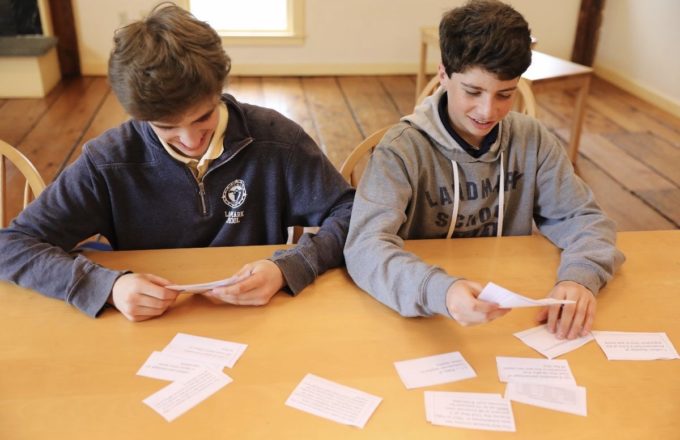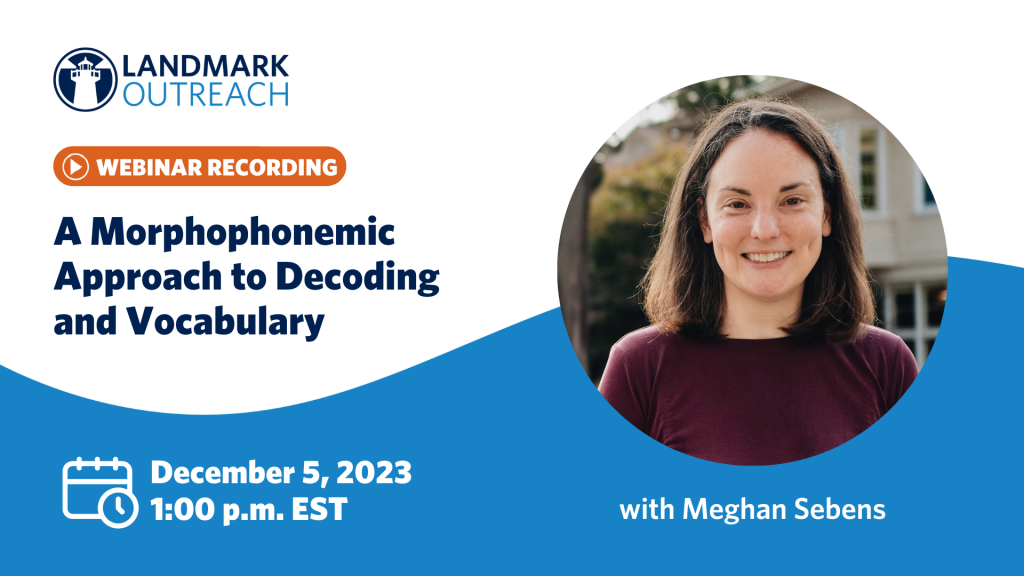The Importance of Vocabulary Development
Vocabulary words are most useful to students when they recognize them in their reading and can use them in their writing. Therefore, it is important to introduce students to unfamiliar words before they are exposed to them in a text. If students come across an unfamiliar word while reading, they are more likely to wonder about its meaning if they have at least seen or heard it before. If they remember learning the word, then their comprehension will improve.
Vocabulary words are most useful to students when they recognize them in their reading and can use them in their writing. Therefore, it is important to introduce students to unfamiliar words before they are exposed to them in a text. If students come across an unfamiliar word while reading, they are more likely to wonder about its meaning if they have at least seen or heard it before. If they remember learning the word, then their comprehension will improve.
Step 1: Locate useful and important vocabulary words
To find vocabulary words for students to learn, turn to any of the following sources:
- Textbooks: Use boldfaced words.
- Novels and short stories: Read ahead and write down a few possibly unfamiliar words from the reading assignment that your students are about to complete.
- Vocabulary workbooks and guides: Choose words that are relevant and useful to your current unit of study. Some suggestions are:
- Elementary: McGraw-Hill Education Vocabulary Grades 3-5
- Middle: 100 Words Every Middle Schooler Should Know
- High: Hot Words for the SAT
Step 2: Help students create a set of vocabulary cards
- Choose one or two vocabulary words each day and put them on the board. More than 2 words can be overwhelming and detract from a student’s ability to recall and use them.
- Using one notecard per word, have students write the word on one side, then the definition, part of speech, and a context sentence on the other side. The context sentence can be useful as hint when students can’t immediately recall a word. A model and example can be seen below:
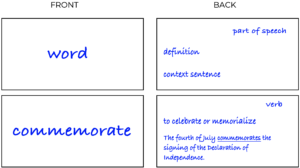
- Make sure that your students keep their vocabulary cards together somewhere in the classroom where they will not get lost and can be accessed easily during class time. Having a card box or putting vocabulary on rings are both useful organizational strategies.
Step 3: Help students learn the words by using their cards
Once each student has a collection of at least 10 word cards, start using them in review activities to reinforce meaning and use. This reinforcement can take many forms, and it is usually more helpful when it taps into the student’s creativity and/or personal learning style. Try the following activities as context vocabulary practice:
- Creative Writing: Ask students to use 3-5 of their words to write a story, descriptive paragraph, etc. These words can be chosen at random or selected deliberately based on their relevance to the topic or the need for practice to achieve mastery.
- Formal Writing: When students have a composition or summary to write for class, have them choose a set number of words to incorporate into that writing assignment.
- Picture Writing: Show your students a photo or piece of artwork to describe using 3-5 vocabulary words (chosen by you or the students). Then, ask them to write a brief description of what they see using the identified words.
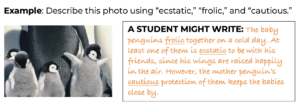
- Word Drawings: Ask students to illustrate words that aren’t sticking in memory. If they don’t want to draw, then finding an image that they think represents the word works, as well. This strategy is beneficial for visual learners because they can associate the definition of the word with an image.
- Synonyms & Antonyms: Ask students to choose a word from their collections (or have them all use the same word).
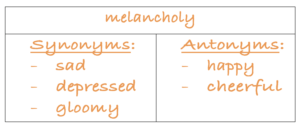 Hand out paper and ask them to write that word on the top of the page, then fold it lengthwise. In one column, ask students to write synonyms for that word, then fill the other side of the paper with antonyms. This can be turned into a timed activity, a competition, or a reference sheet, depending on the personality and needs of your class.
Hand out paper and ask them to write that word on the top of the page, then fold it lengthwise. In one column, ask students to write synonyms for that word, then fill the other side of the paper with antonyms. This can be turned into a timed activity, a competition, or a reference sheet, depending on the personality and needs of your class. - Structured Pull-outs: Ask students to pull cards for specific words out of their collection and tell you what they have in common.
- Example: Identify the words “revolutionary,” “original,” and “innovative.” Ask student to identify they have in common. What is something that they could all describe?
- Independent Pull-Outs: Give the class a category ask students to choose 3 words from their collections that could fit into that category.
- Example: Have students identify 3 words that could describe a happy moment. When they are done, ask them what words they chose and why those words fit the chosen category.
- Word Chains: Take a vocabulary word that you can manipulate and make a chain out of it, changing part of speech, prefixes, suffixes, etc.

- Card Games: Play go-fish, memory, to match words to definitions, match words with similar meanings, etc.
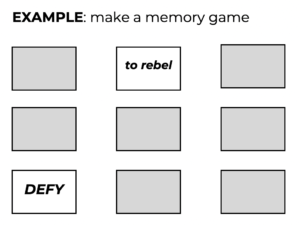
Step 4: Ensure individual student mastery
Once students have 10 vocabulary words in their collection and have had adequate practice with them, formally assess them on their knowledge meanings and uses of these words. This assessment can be a quiz, writing assignment, or one-on-one oral drill. Words that they definitely know can be placed aside, while those that still pose a challenge to the student should be kept in active use as they increase the number of words in their collections. Come back to the familiar words every once in a while so that students don’t forget them, but focus your activities on allowing them to learn the words that they still struggle to use or define correctly. Note: At this point, each student’s collection will start to look different, depending on how quickly they individually master new vocabulary words.
